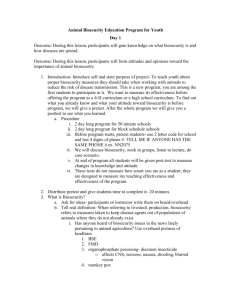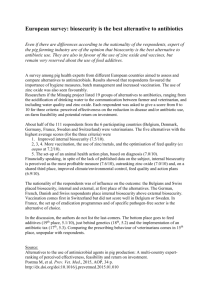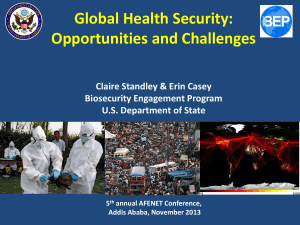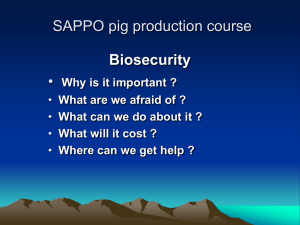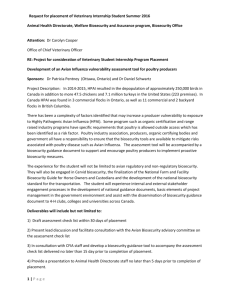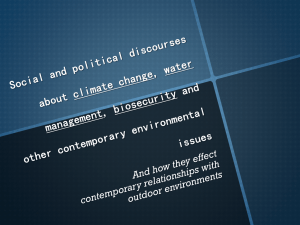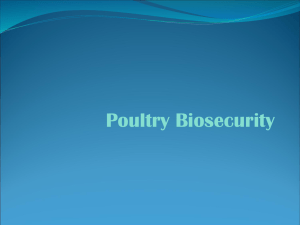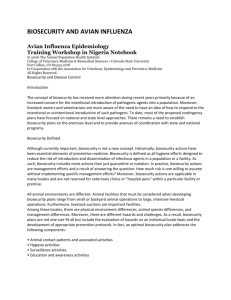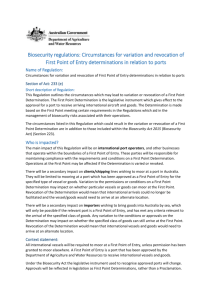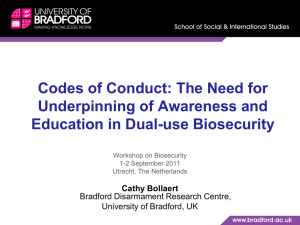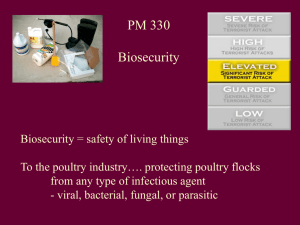Biosecurity in Aquaculture - RR-Middleeast
advertisement
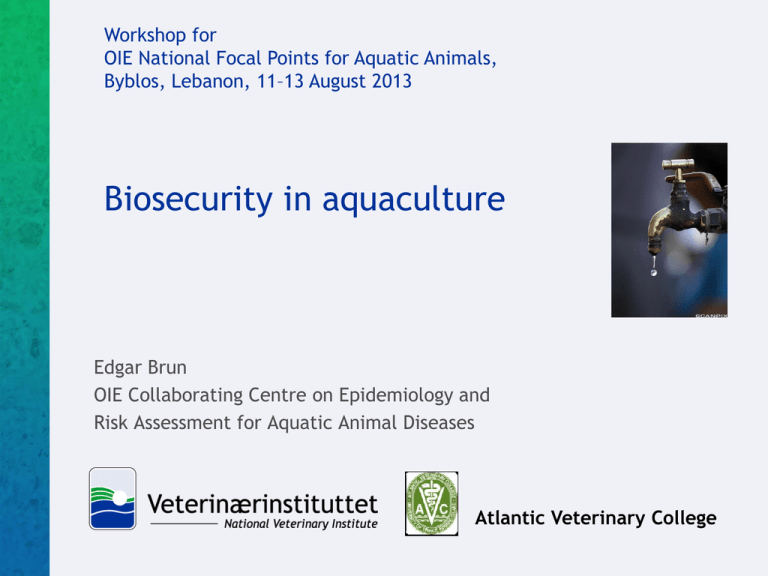
Workshop for OIE National Focal Points for Aquatic Animals, Byblos, Lebanon, 11–13 August 2013 Biosecurity in aquaculture Edgar Brun OIE Collaborating Centre on Epidemiology and Risk Assessment for Aquatic Animal Diseases Atlantic Veterinary College Biosecurity A holistic concept for the sustainability of aquaculture (food production) Aims to protect environment including biological diversity Based on regulations and standards to be applied at international-, national- and site level Biosecurity Every action involved in ● avoiding entry of pathogens (prevention/exclusion) Into a country into a farm ● controlling further spread of pathogens (containment) ● reducing consequences of outbreaks (eradication) Cultured aquatic animals are traded world wide as eggs, live animals and products are kept in open or semi-open systems are part of the local ecological system ● are continuously exposed to environmental microorganisms (and visa versa) are more “stressed” than surrounding fellow animals in the wild Three levels within biosecurity National/international level – governmental responsibility Regional level – shared/industry responsibility Site level – company/private responsibility International/national level International standards (OIE, WTO, Codex) National legal framework Management policy (hazards, surveillance, stamping out, compensation …) Authority for implementing control measures at national, regional and site level Infrastructure ● Lines of command ● Laboratories ● Reporting system ● Information system ● Competence building Regional level Epidemiological unit How is the connection between farms Can groups of farms be organized into zones Regional collaboration Interaction between big intensive companies and small (semi-) extensive private enterprises Can coordinated measures be implmented at the same time Example; development of PD in Norway PD-outbreaks 1995-2010 Total number of outbreaks per year 120 100 80 60 40 20 0 1995 1996 1997 1998 1999 2000 2001 2002 2003 2004 2005 2006 2007 2008 2009 2010 PD- distribution in Norway 2008-2010 Hustadvika Biosecurity measures to an emerging disease (ISA) 90 80 70 60 50 40 30 20 10 0 700 600 ISAV identified 500 400 300 200 100 0 2004 2002 2000 1998 1996 1994 ISA made notifiable 1992 1990 1988 1986 1984 First occurrence of ISA Official guidelines for the handling of outbreaks Contingency plan, revidert Introduction of zones to combat outbreaks Regulation on disinfection of wastewater from slaughterhouses and processing plants, and of the seawater supply in hatcheries Compulsory health certificate Compulsory health control in hatcheries Regulations on transport (vehicles and hygienic measures) Ban on using seawater in hatcheries Ban on moving fish already put to sea The ”Stop ISA campaign” Biosecurity at site level Wild aquatic animals abiotic biotic Environment abiotic biotic biotic Farmed aquatic animals Import/trade Biosecurity at site level Described in a BIOSECURITY PLAN ● Based on a biosecurity risk assessment ● SOPs for various tasks/procedures ● Routine health/disease monitoring ● Contingency plans ● Should be generic ● The plan should be understood and respected by all employees (biosecurity awareness) ● Routines for auditing and updating Biosecurity assessment at site Risk characterization of the facility Pathogen exposure Risk characterization of management Identification of critical points Risk characterization of the facility Location and physical lay-out Internal production flow Separation into sub-units Pathogen exposure Which infectious hazards are threatening the plant, their epidemiology and control measures ● ● ● ● ● ● routes of introduction and spread What do we know about the infectious agents What do we know about the disease Does the farm have susceptible species Available diagnostic test Available vaccines Introduction routes Oidtman et al 2011 Disease transmission in fish Direct contact between fish ● ● Ingestion (oral) ● ● ● Vertical or horizontal Entry through skin, open wounds, gills Infected live or frozen fish Cannibalism of dead or dying fish Contaminated feed Water Sources ● ● Inputs, transfer Including aerosols Spray or splashes between tanks Dr. Alain Le breton Disease transmission in fish Fomites: Inanimate objects ● ● Vectors: Living creatures ● ● ● Equipment: Nets, buckets, siphon hoses Footwear, clothing, vehicles Predatory birds, wildlife Pets People Zoonotic: affects people ● Bacterial agents Mycobacterium Edwardsiella Erysipelothrix Klebsiella ● Parasitic agents Anisakis Dr. Alain Le breton Risk characterization of management Operations and routines ● ● ● ● ● ● ● Routines for disease control Handling of diseased fish Awareness for early disease detection Data registration Clear responsibility Traffic control Disinfection Competence ● Biosecurity awareness ● Knowledge of basic hygiene principles ● Basic knowledge of diseases Risk based characterization of a farm – control of fish movement Dr. Alain Le breton Production function Resource input (animals, feed, labour, etc.) Production process Output: goods, services (to satisfy human needs) Biosecurity Diseases Diseases will reduce the efficiency by which input are converted into output Biosecurity • will reduce the probability of infectious exposure (known and unknown) and curtail its effect (holistic) • is additional input to the production function • may increase output or lower the need for input • should be balanced between benefit and cost Core issues to Balance knowledge on hazards, technical feasibility and cost Tailor the biosecurity plan according to the specific needs on each individual farm Biosecurity … everybody will sooner or later face the challenge of a disease outbreak …is an act of responsibility ● to the farmed animals ● to the environment ● to fellow producers ● to society THANK YOU FOR YOUR ATTENTION
